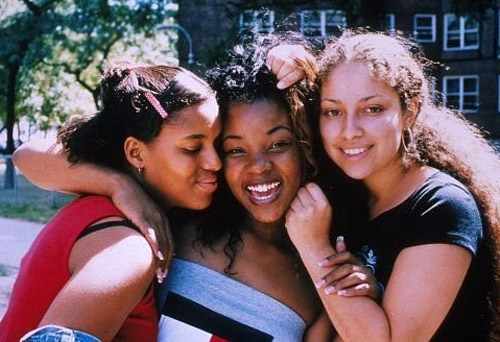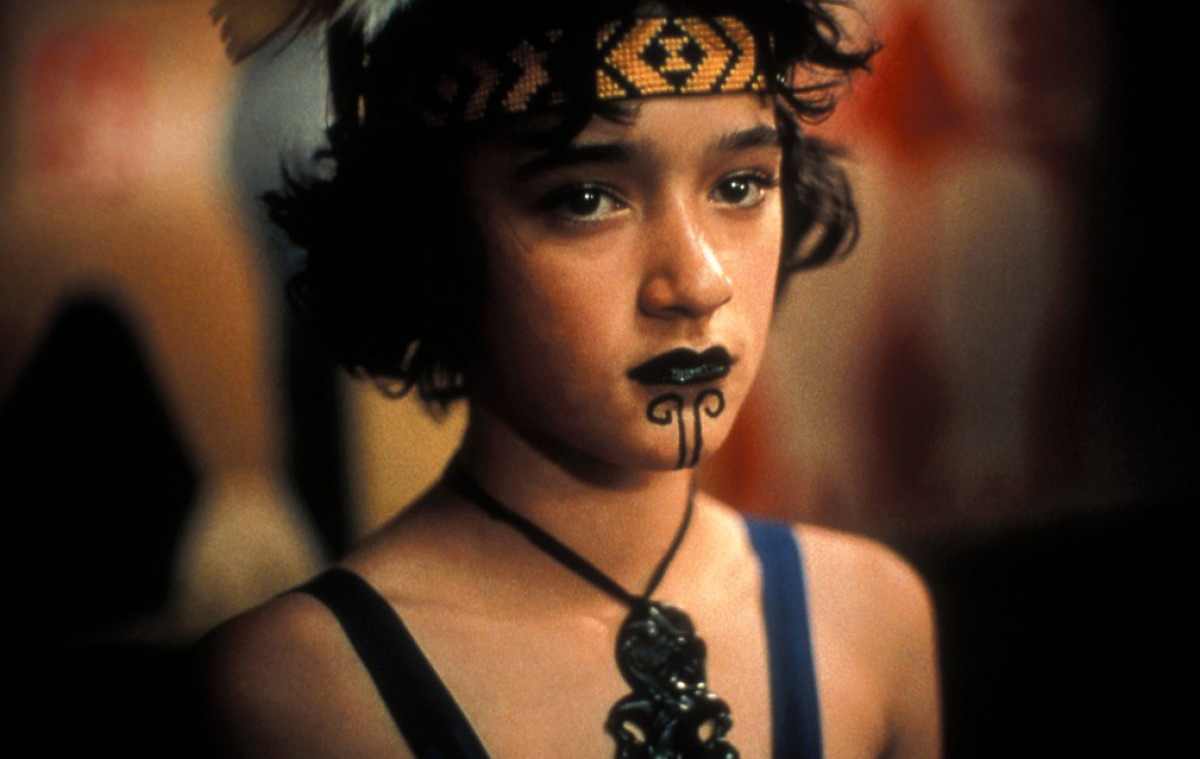Coming-of-age films like the current art house hit Boyhood usually focus on…boys. A girl character can be, like in the Harry Potter films, The Sidekick, (Emma Watson as Hermione) or just The Girlfriend as in Wes Anderson’s early film Rushmore. If we’re lucky we get to see a complex teenage girl character who is The Daugher, like Shailene Woodley in The Descendants. Until recent YA adaptations like The Hunger Games and The Fault in Our Stars a teenaged girl was rarely The Person the film was about. And teen girls of color? Movies are still pretty much never about them.
In the 90s and early 2000s we seemed on the cusp of a sea change in which a white male teenager wasn’t the default character audiences were supposed to identify with. While films about grown women had stars like Whitney Houston (in The Bodyguard) Angela Bassett (Oscar-nominated for What’s Love Got To Do With It) and a pre “J. Lo” Jennifer Lopez (in Selena), films about teenaged girls of color popped up too. Leslie Harris’s Just Another Girl on the IRT was released in the early 90s. In 2000 writer-director Jim McKay’s gorgeous, melancholy Our Song, about the friendship of three teenaged girls of color (which starred Kerry Washington–in her film debut) opened in theaters.
McKay (who is white) has said in interviews that part of why he wanted to make the film was to include the Jackie Robinson Steppers marching band (now known as The Brooklyn Steppers) a Brooklyn institution of Black and Latino young people which incorporates R and B and hip-hop music and dance moves into its repertoire. The scenes with the band (which the three girls all belong to) are a resounding success: all marching bands should be like this one! The real marching band members and the main actresses, Anna Simpson as Joycelyn, Melissa Martinez as Maria, and a very young Washington as Lanisha blend seamlessly into the group. The band leader (Tyrone Brown) is a character many will recognize from their own lives, especially when he lectures the band in the manner of every teacher, advisor and coach who has implored students to please try harder. Also seamless is the way other scenes of the girls interacting with their acquaintances leaves us unaware of who is a professional and who is not (the film cast people in the neighborhood alongside actors with long lists of credits): this smooth interweaving of scripted and documentary elements reminded me of the Chilean film No and its mix of vintage documentary video with scripted scenes that take place during the same events. McKay also seems to have a talent equal to Lukas Moodysson’s in writing believable and affecting dialogue for teenage girls. The naturalistic acting of the leads, especially Washington, but also Simpson and Martinez, elevates the sometimes pedestrian talk about clothes and boys into a music of its own.

Seen today, the film is an unwitting nostalgia piece: the Crown Heights neighborhood in Brooklyn where the scenes were shot is largely gentrified now. In the film’s action we rarely see a white face, a contrast with recent, independently made films that take place in Brooklyn like Obvious Child and It Felt Like Love in which–as in most mainstream films, no matter where they take place–the audience rarely sees anyone onscreen who is Black or brown. We get a hint of the white influx to come when Joycelyn learns from her new high-status friends what a “mocha” is and teaches it to Lanisha and Maria who, in their mostly low-income neighborhood (which they rarely leave) have never heard the term before. Joycelyn’s job is at what seems to be The Body Shop while Lanisha and Maria work at a local, decidedly non-artisanal bakery.
At work and off Maria and Lanisha sometimes speak Spanish to each other (in one of the film’s many instances of casual bulldozing of stereotypes, Maria starts out knowing no Spanish even though her family is Latino). In one scene Maria tells Lanisha she’s “embarazada.” Lanisha, used to correcting her friend, laughs and says, “‘Embarazada’ doesn’t mean ’embarrassed.’ It means you’re pregnant.”
Maria answers, “I know what it means. I looked it up.”

Maria’s passivity and seeming apathy when confronted with making decisions about her pregnancy, practice with the band, or enrolling in a new school feel true-to-life: her response to these challenges, except in the scene where she confronts the father of her baby–who doesn’t even bother to take off his headphones when she tells him the news– seems to be one big shrug, with a teenager’s lack of regard for later repercussions. Of course, of the three mothers we see, Maria’s is, by far, the least understanding and most strict: teenagers who figure out that their parents are unreasonable are usually the ones who get into the most trouble.
The film is a treasure trove of thoughtful characters who are women of color, not just the three girls but also Marlene Forte as Lanisha’s mother, gently trying to warn her daughter about her charming father’s broken promises, and even, in a brief scene, a counselor (Iris Little Thomas) who makes Maria laugh when she tells her that she too was quiet when she was her age, but now nobody can get her to shut up. About Maria’s pregnancy the counselor says, “I was just remembering ’15’ and just wondering what you might like to do.”
In the film’s closeups (the stunning cinematography is by Jim Denault) we see how little imagination fashion magazines and mainstream TV and films have in their extremely narrow vision of what makes girls and women “beautiful.” On nights out, when she undoes her usual thick braid, Maria has a glorious, long, full, frizzy lion’s mane of hair, set off by huge hoop earrings; Joycelyn’s almond eyes and velvety, dark skin are highlighted by her sparkly eyeshadow (which her very young mother, to whom she has a strong resemblance–and who acts more like her buddy and roommate–seems to borrow) and Lanisha, whose radiant, expressive face is both familiar to us, from Washington’s later stardom, and not–Washington is less slender here than we’re used to seeing her, with shorter hair and in belted, baggy jeans (fashionable for teen girls then) instead of the well-cut designer clothing she wears on the red carpet or on Scandal.
At a time when neighborhoods of mostly Black and Latino people were demonized as full of gangs and lawlessness, the only crime we see is when the girls shoplift new clothing for themselves. The film’s one instance of deadly violence is a despair-ridden murder-suicide. At the makeshift, poster board memorial for the victims, the three girls solemnly place the roses Joycelyn, though she is spending more and more time with her new friends, bought at the bodega for each of them.
The “our song” of the title is “Ooh Child” which the band rehearses and we also hear on the radio (the 1990s Chyna version, not the original Five Stairsteps’ version from the 70s). The girls first hear the song together and then, more poignantly, when they’re apart.
The girls’ increasing estrangement is a reality not often depicted on film, where friendship (unless it involves an obvious villain or some big blowout fight) usually equals “forever.” But for most of us, different people drift in and out of our lives in high school and beyond. In the last shots of the film we see a long closeup of Lanisha by herself, without either friend at her side. We recognize she is having her first, sad inkling that most of her “best friends” will move on and away from her–or she will move on from them.
[youtube_sc url=”https://www.youtube.com/watch?v=jINf6OTWyUE”]
__________________________________________________
Ren Jender is a queer writer-performer/producer putting a film together. Her writing. besides appearing every week on Bitch Flicks, has also been published in The Toast, RH Reality Check, xoJane and the Feminist Wire. You can follow her on Twitter @renjender.







